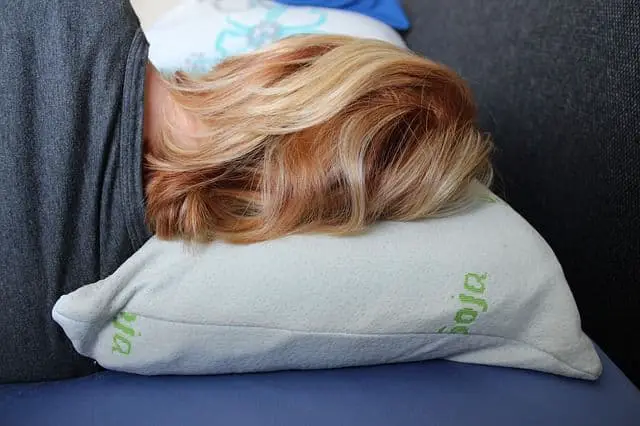Having a good night’s sleep does not depend on how dark the room is or how much smooth jazz music you play before stepping into dreamland. It all depends on how you lay down while sleeping.
Finding a comfortable sleep position may be difficult sometimes. This is particularly hard if one has broad or wide shoulders and prefers to sleep on their side. Side sleepers with broad shoulders often end up scrunching up their shoulders or neck with aches and pains. There are special pillows available for neck alignment to help provide a pain-free good night’s sleep on your side.
This article explores some of the ways you can improve your sleep pattern when suffering from broad shoulders.
How Do Broad or Wide Shoulders Induce Pain While Sleeping?

If a person has broad shoulders, some sleeping positions induce more pain and aches than others. Here are a few factors that can cause this pain:
Improper neck alignment
The position you place your neck during sleeping is very important for making sure that you wake up pain-free. Side sleeping can give certain issues with neck alignment if you are not making use of the right pillow.
Tight shoulders
Side sleepers usually tend to scrunch shoulders up towards their ears when they are sleeping. This usually happens because ultra-thin pancake pillows are being used that do not support the neck and head sufficiently.
This is particularly true for people with wide or broad shoulders as standard pillows do not usually fit between the head and neck.
There is a wide range of sleepers. Some can just nod off on their stomachs, while others must spread out over the bed. Some twist up into little balls, and some find that dozing on their back is the best approach.
Whichever you pick, it is imperative to realize that your sleeping position can influence how you feel at the beginning of the day and for the duration of the day. In this article, we will focus on the side sleeper, the most well-known sleeping position.
What Is a Side Sleeper?

A side sleeper is basically someone who sleeps on their side. You can consider yourself a side sleeper if you disregard sleeping on your stomach or back in return for laying down with your shoulder and hip directly on the bedding.
Side sleeper relationship to personality
The facts confirm that while we spend about 33% of our lives sleeping, we do not regularly stop and think about what our sleep positions reveal about our characters.
An investigation by Professor Chris Idzikowski, Director of the Sleep and Assessment Advisory Service, highlights that like our non-verbal communication during the day, our intuitive sleep position may provide clues as to our specific personality characteristics.
While little research was performed in the past, sleep studies are starting to investigate the link between sleep position and personality in more detail.
How to sleep on your side
Whether you are a veteran side sleeper, or you are new to the side sleeping position, it is very important and crucial to know how to sleep on your side with broad shoulders.

This way, you can have the benefit of the side sleeping position without suffering discomfort and pain the next morning:
- First, lie down on a medium-firm mattress, use one firm pillow under your head.
- Then shift over to the left side first. Your ears should be parallel or in-line with the shoulders, while the chin must remain neutral. Avoid tucking the chin into your chest or keeping the head down.
- Keep your hands and arms below the face, more preferably parallel to the side of your body.
- Then put a firm and comfortable pillow between the knees, especially when you are suffering from low back pain. This will help prevent the collapse of the knee and hip joints, hence creating a better alignment in the spine.
- Lift your knees slightly towards the chest to help reduce pressure on the back.
Sleeping on your side in correct alignment with broad shoulders may offer immense benefits to both mind and body.
This article is owned by Sleeping Report and was first published on March 17, 2020
But if you continuously experience pain, you should consider swapping out the pillows and mattress for firmer support. Consult a chiropractor or doctor if you experience chronic pain despite making these changes.
Note: Numbness in the hands can be reduced if you sleep on your left sid. Waking up in the morning to an unexplained numbness in your hands can be surprising and an alarming symptom.
However, this is usually nothing to worry too much about if this is the only symptom. Numbness is often the result of nerve compression due to your sleeping position.
If you have numbness in your hands alongside some other uncommon symptoms such as numbness across the body, then you should try to sleep on your left side – you should also consult your healthcare provider. Nerve compression can take place when something renders extra pressure on the nerve.
If numbness occurs in your hands, then it is likely due to the compression of the radial, ulnar, and median nerves. These nerves initiate from the neck. They then run down towards your hands and arms, giving a net-like appearance. If you sleep on your left side with proper support using pillows, then you may help reduce this numbness.
Within the side sleeping position, there are several sub-positions:
Fetal Position

The fetal position includes twisting up like an infant, with your knees curled up to your chest. 41% of people surprisingly default to this dozing position settling on it as the most mainstream choice.
The Log Position
The log position is another common sleep position. If a sleeper sleeps on his or her side with their arms oriented downwards and close to the body, they prefer the log position.
Yearner Position

The yearner position is another sleep position that is used by many people. The yearner sleepers sleep on their side with their arms stretching forward in front of them.
Pillow Hugger Position
Pillow huggers are often cuddly people that sleep on their side while embracing the pillow and holding it close.
The Thinker Position
A variation to the fetal position is the thinker position, with a twist. Thinkers sleep by putting their chin on their hands, giving observers the impression that the sleeper is pondering life’s big questions.
Side Sleeping Positions for Well-being
Sleeping on your side is much gentler on your neck than dozing on your stomach. Many studies show that resting or sleeping on your side can apply pressure on your arms and legs.
In fact, one of the studies found that sometimes this can lead to carpal tunnel syndrome. So, if you are stressed over this hazard, but cannot envision switching from your usual sleeping position, then take a stab at altering it in two different ways.
To start with, ensure that your arms are somewhere near your side. Lying down with your arms over your head or maybe around your cushion can squeeze your lower shoulder. To avoid this, lay down with your arms somewhere around your side.
You can likewise have a go at lying down with a pad between your legs. This basic convenience can prevent your legs from adding any additional strain to your back.
Concerning resting or sleeping at your side, it is essential to note which side you lay on or sleep. This is because of our body’s structures and the area of our organs.
On the off chance that you go with your left side, you will be glad to discover that sleeping on the left is ultimately related to an entire range of advantages.
It can mitigate indigestion and heartburn, help with absorption, improve circulation, and promote drainage of the toxins from the lymph nodes. There also appears to be a link between sleeping on your right side and acid reflux.
Tips for Side Sleepers to Have a Good Night Sleep

For a good night’s sleep as a side sleeper, follow the tips below:
Find a mattress that supports your body
If you experience arm pain or shoulder discomfort while sleeping on your side, you need to move around the mattress firmness to accommodate your side sleeping position.
This is honestly something you need to consider when purchasing a new mattress. Buying a new mattress is an expensive purchase, and it’s hard to swap out your mattress for a new one if you find your mattress doesn’t support your body correctly.
The best mattress for you depends on your personal preferences. Unless you already know that you like a certain type of mattress, you shouldn’t order something online and hope for the best. Head to a local mattress store and figure out whether you want something particularly firm, soft, or somewhere in between.
Be gentle on the hip and shoulder
You should also avoid applying too much pressure on these vital body parts. An improper sleeping position that leads to hip or shoulder pain can be hard to fix in the long run.
When falling asleep, ensure that your arm is tucked in a way that won’t aggravate the shoulder during your slumber. Any minor discomfort you feel now will be exponentially increased when you wake up in eight hours.
Also, you should ensure that your hip is free of discomfort. This is harder to achieve because there isn’t much you can do to reposition your hip during sleep. However, you can still position your body to avoid any hip pain that you might feel before bed.
Choose a firm pillow
Pillows that are firm and soft will keep your head off the mattress. More specifically, you should keep your head between your two shoulders.
Keep a thin pillow between your knees when sleeping
This will prevent soreness in the hips and keeps the knees and their skin from banging with each other.
Pain in your back and your legs can be observed in many side sleepers due to lack of support. When a sleeper sleeps on their side, the bottom half of the body supports the weight of the opposite side.
Concerning the legs and hips of the sleeper, the body takes on an awkward stance all night, which is not good for joints. Putting a pillow between the knees straightens the hips into a healthy spinal alignment, thus alleviating the pressure on the back and the rest the body.
Straddling a pillow may offer near-instant pressure relief that will help you to have a sound and good night’s sleep.
This article is owned by Sleeping Report and was first published on March 17, 2020
Use more pillows
When we talk about side sleepers, the more pillows you use when sleeping, the more comfortable you will be. Experiment with placing pillows behind the back or hug a pillow until you come up with the best and most comfortable combination.
Sleep on your left side
If you are suffering from sleep apnea, or if you are pregnant, or snore, sleeping on your left side is a good rule of thumb. Because of the location of internal human organs, it is better to sleep on the left side.
The stomach’s natural position is also on the left side. This improves the gastric position of the stomach and allows the stomach to digest food more effectively and so moves it along in a well-organized fashion.
If you sleep on the right side, all the late-night snacks you consume will struggle against gravity and hinder good digestion. This position is the main reason why some sleepers experience heartburn.
Left side sleeping promotes healthy blood flow and provides positive effects on the digestive system, including the reduction of acid reflux and decreased heartburn symptoms. Always remember the phrase “left is right, and the right is wrong”!
Do not sleep on your arm
Sleeping on your arm is one of the favorite positions of many sleepers. Usually, sleepers put the arm under the pillow. It may feel quite comfortable before you fall asleep, but this position is not good for your body.
Sleeping on an arm can cause numbness and pain in the arm and the shoulder, too. Moreover, it can also misalign your neck and head, resulting in further discomfort. It can also block the circulation towards the arm.
Does sleeping on the side affect your shoulder?
Some doctors discourage side sleeping as it can render damage to the shoulder’s rotator cuff. Side sleepers place a lot of pressure on the group of tendons, so require a pillow with good support.
What If You Do Not Sleep on Your Side?

Sleepers who choose to lie on their front and back are also not giving the body its most natural position.
Unless you sleep on your left side, you may experience a higher chance of suffering heartburn and acid reflux, as well as aches and pains from head to toe.
When we are molding ourselves into a yoga pose at the gym or at the yoga studio, we consciously avoid any kind of injury by adjusting the yoga pose to gain the maximum benefits from it.
The same should be considered for slumber.
Sleeping positions have a big impact on our health. The position you choose affects everything from your brain to your gut.
Not having adequate sleep can leave you as energetic as a sloth, but if you are managing to sleep seven to eight hours sleep per night but are still waking up with low energy or feel lackluster, then you should consider checking out what you do after turning out the lights.
For Better Digestive Health, Adopt a Left-Side Sleeping Habit

Sleeping on the left side provides several advantages that are backed up with scientific evidence and have proven health benefits.
Though our bodies appear symmetrical on the outside, the internal organ placement makes the body asymmetrical on the inside. How we sleep determines the resting position of these organs and influences how waste will be eliminated from our bodies and how the digestive system will process food.
Many people give a lot of attention to maintaining their health by working out and eating healthily to lose weight. But why don’t we give our digestive health and the stomach the same level of attention?
Start your night laying on the left side to help prevent heartburn and allow gravity to assist with the progress of waste through the colon. If your shoulder begins to feel painful or numb, it is OK to roll onto the other side.
It is always a good idea to place a pillow between the legs and hug a pillow to help support the spine. When you sleep at night on the left side, gravity helps assist waste on a trip through the colon and may result in more trips to the bathroom!
Conclusion
The best and the most comfortable sleeping position is to sleep on your side. It is preferable to sleep on your left side. This promotes the healthy working of all the body’s organs and ultimately provides sound sleep.
SleepingReport.com copyright article was updated on ..
However, for broad-shouldered sleepers, sleeping on their side can cause a painful night’s sleep. This pain and discomfort can be avoided with the use of pillows to position and prop yourself up.

